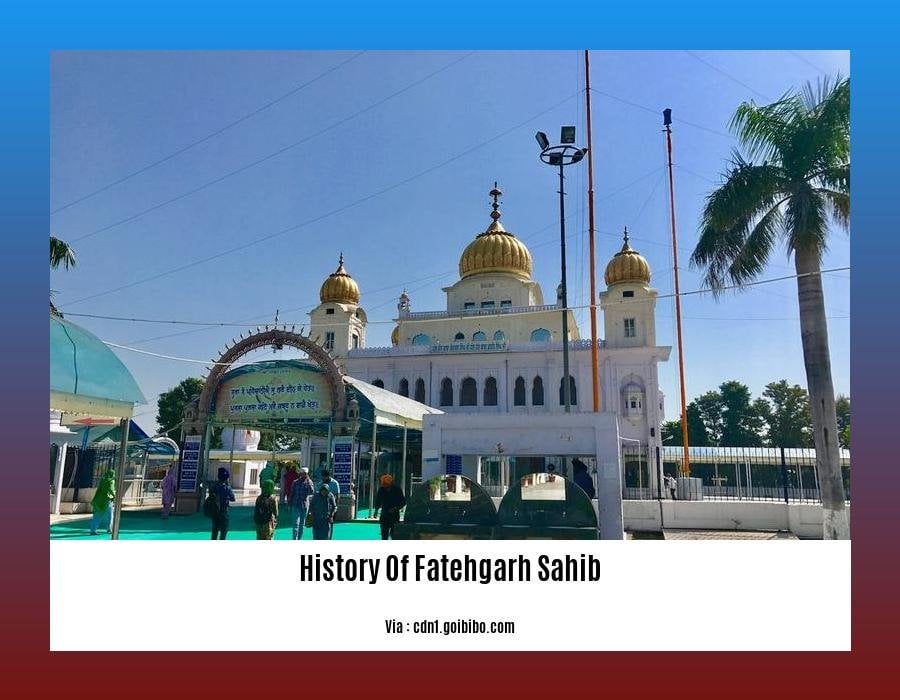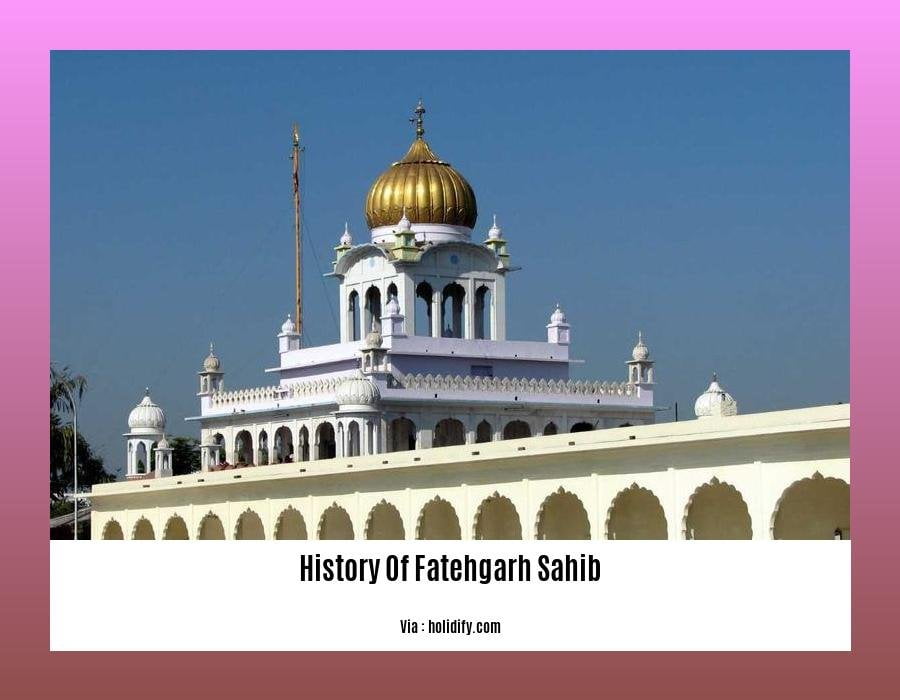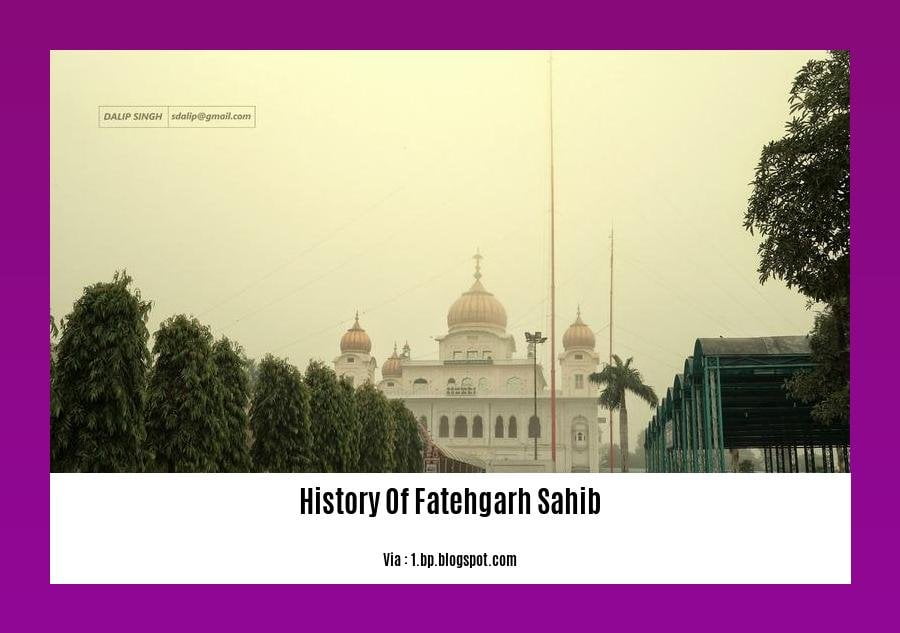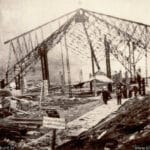Unveiling the History of Fatehgarh Sahib: A Sikh Stronghold in Punjab. The annals of Fatehgarh Sahib, a city deeply intertwined with the Sikh faith, are etched with tales of valor, sacrifice, and resilience. From its humble origins as a small village to its transformation into a flourishing Sikh stronghold, this region has witnessed pivotal events that shaped the course of Punjab’s history. Join us as we embark on a journey through time, uncovering the captivating stories that lie within the heart of Fatehgarh Sahib.
Key Takeaways:
- Fatehgarh Sahib is a district in Punjab, India, named after Fateh Singh, the 7-year-old son of Guru Gobind Singh.
- Fateh Singh and his brother Zoravar Singh were martyred by the Mughal Army under Wazir Khan’s orders during the ongoing Muslim-Sikh war in the early 18th century.
- The district was formed on April 13, 1992, and is named after Sahibzada Fateh Singh.
- The site of Fatehgarh Sahib is now home to Gurudwara Fatehgarh Sahib, a prominent Sikh pilgrimage site.
The Enigmatic Fatehgarh Sahib: A Testament to Sikh Resilience

Fatehgarh Sahib, a district nestled within the heart of Punjab, is a place steeped in historical significance, particularly in the annals of Sikh history. Its very name, derived from Fateh Singh, the young son of Guru Gobind Singh, evokes a poignant tale of sacrifice and resilience that has left an indecipherable mark on the region’s identity.
The Tragic Saga of Sahibzada Fateh Singh and Zoravar Singh
In the early 18th century, during the tumultuous period of the Muslim-Sikh war, Fatehgarh Sahib became the stage of a somber tragedy that would forever emblazon its name in history. Sahibzada Fateh Singh, a mere 7 years of age, alongside his elder brother Zoravar Singh, fell victim to the ruthless brutality of the Mughal forces led by Wazir Khan.
In an act of unspeakable cruelty, Khan ordered the young princes to be bricked alive, a sentence that shook the foundations of the Sikh community. Their martyrdom at such a tender age transformed Fatehgarh Sahib into a potent symbol of Sikh resilience and unwavering faith in the face of adversity.
The Enduring Legacy: Gurudwara Fatehgarh Sahib
Today, Fatehgarh Sahib stands as a testament to the indomitable spirit of the Sikh people. At the very site where the Sahibzadas met their tragic end, stands the revered Gurudwara Fatehgarh Sahib, a sanctuary that draws countless pilgrims from far and wide.
This gurdwara, with its awe-inspiring architecture and tranquil ambiance, serves as a poignant reminder of the sacrifices made by Fateh Singh and Zoravar Singh. Within its hallowed walls, devotees pay homage to the young martyrs, seeking solace and inspiration from their unwavering devotion to their faith.
Fatehgarh Sahib: A Source of Pride for Punjab
The history of Fatehgarh Sahib is inextricably intertwined with the broader narrative of Punjab, a state renowned for its rich cultural heritage and unwavering spirit. The district has emerged as a beacon of Sikh history, attracting scholars, historians, and pilgrims eager to delve into the region’s past.
Fatehgarh Sahib’s resilience in the face of adversity has become a source of pride for the people of Punjab. Its story, etched in the annals of history, continues to inspire generations, reminding them of the indomitable spirit that defines their shared heritage.
- To discover the evolution of the England Rugby team’s uniform throughout the years, delve into the history of England rugby shirts.
- Explore the captivating history of entrepreneurship in Kenya and learn about the inspiring individuals who have shaped its business landscape.
- Immerse yourself in the captivating history of Europe in Hindi and gain a comprehensive understanding of the continent’s rich past in your native language.
Role in the Sikh Resistance Movement
Fatehgarh Sahib played a crucial role in the Sikh Resistance Movement, emerging as a bastion of resilience and bravery. Let’s delve further into its remarkable significance:
Triumphant Conquest:
- In 1710, Fatehgarh Sahib experienced a historic triumph when Banda Singh Bahadur and his valiant Sikhs captured the city of Sirhind.
- This victory symbolized the indomitable spirit of the Sikhs, asserting their unwavering resistance against Mughal oppression.
Sacred Shrine:
- Following the conquest, Banda Singh Bahadur constructed a Gurdwara to honor the younger sons of Guru Gobind Singh, the tenth Sikh Guru.
- Gurdwara Fatehgarh Sahib, built on the site of their martyrdom, became a sacred sanctuary, deeply revered by the Sikh community.
Martyrdom of the Sahibzadas:
- The city’s most poignant chapter unfolded when the younger sons of Guru Gobind Singh, Baba Zorawar Singh and Baba Fateh Singh, faced a tragic fate.
- Despite their tender age, they stood坚定地 opposed to forceful conversion to Islam, embodying the Sikh spirit of unflinching conviction.
- Their martyrdom left an enduring legacy of resilience and determination, inspiring generations to stand steadfast in their beliefs.
Enshrined Resistance:
- Fatehgarh Sahib stands as a living testament to the resilience and defiance of the Sikhs during the resistance movement.
- The city’s history and its sacred Gurdwara serve as constant reminders of the sacrifices made by those who fought for their faith and freedom.
Key Takeaways:
Fatehgarh Sahib was captured by Banda Singh Bahadur, a valiant Sikh warrior, in 1710, symbolizing the Sikh resistance against the Mughal Empire.
The city houses Gurdwara Fatehgarh Sahib, built by Banda Singh Bahadur to honor the younger sons of Guru Gobind Singh.
The martyrdom of the Sahibzadas, Guru Gobind Singh’s sons, who refused to convert to Islam, is a defining event in Fatehgarh Sahib’s history.
Fatehgarh Sahib represents the indomitable spirit of the Sikhs and their unwavering resistance against religious persecution.
The city serves as a sacred pilgrimage site for Sikhs, attracting devotees who seek inspiration from its rich history of sacrifice and resilience.
Sources:
Architectural Heritage and Historical Monuments of Fatehgarh Sahib

Fatehgarh Sahib, a city in Punjab, India, holds a profound significance in Sikh history. Its rich architectural heritage and historical monuments stand as testaments to the resilience and spirit of the Sikh community.
- Fatehgarh Sahib’s Gurdwaras:
- Gurdwara Fatehgarh Sahib: Constructed on the site where the younger sons of Guru Gobind Singh, the tenth Sikh Guru, were martyred, this gurdwara exudes an aura of reverence and spirituality.
Gurdwara Jyoti Swarup: Dedicated to Guru Gobind Singh’s mother, Mata Gujri, this gurdwara is a symbol of maternal devotion and sacrifice, its intricate designs reflecting the rich artistry of the Sikh tradition.
Historical Monuments:
Sirhind Fort: Built by the Mughal governor Wazir Khan, this fort played a pivotal role in the Sikh struggle against Mughal rule, showcasing the architectural prowess of that era.
Architectural Splendor:
- Gurdwara Baoli Sahib: The baoli, a stepwell, and the gurdwara adjacent to it showcase the fusion of architectural styles, embodying the harmonious blend of Mughal and Sikh influences.
- Haveli of Nawab Wazir Khan: This opulent palace, once the residence of Wazir Khan, reflects the grandeur of Mughal architecture, its intricate carvings and elegant arches a testament to the era’s artistic achievements.
Key Takeaways:
- Fatehgarh Sahib’s gurdwaras serve as pilgrimage sites, attracting devotees from across the globe, fostering a sense of community and preserving the Sikh heritage.
- The historical monuments of Fatehgarh Sahib stand as reminders of the city’s tumultuous past, showcasing the architectural heritage of different eras and shedding light on the resilience of the Sikh community.
- The harmonious blend of architectural styles in Fatehgarh Sahib’s monuments reflects the city’s diverse cultural influences, showcasing the region’s rich history and fostering mutual respect among various communities.
Relevant URL Sources:
Contemporary Significance and Cultural Legacy
Fatehgarh Sahib stands as a testament to the indomitable spirit of the Sikh community. This sacred land has witnessed pivotal moments in Punjab’s history, shaping its cultural and religious identity. In this article, we delve into the contemporary significance and cultural legacy of Fatehgarh Sahib, a land where Sikh heritage intertwines with the tapestry of Indian history.
Sikh Pilgrimage Site
Fatehgarh Sahib holds immense significance as a pilgrimage site for Sikhs worldwide. Devotees flock to Gurdwara Fatehgarh Sahib, a revered shrine commemorating the martyrdom of Guru Gobind Singh’s two young sons, Zorawar Singh and Fateh Singh. This sacred complex epitomizes the Sikh spirit of resilience and sacrifice, drawing pilgrims from across the globe to pay homage to these revered martyrs.
Historical Importance
Fatehgarh Sahib has played a pivotal role in shaping the historical narrative of Punjab. The city served as the capital of the Sikh kingdom under the leadership of Maharaja Ranjit Singh, a visionary ruler who transformed Punjab into a prosperous and powerful state. His reign ushered in an era of peace and stability, leaving an indelible mark on the region’s history.
Architectural Heritage
Fatehgarh Sahib’s architectural heritage reflects the rich cultural tapestry of Punjab. The city boasts several historical monuments and gurudwaras, each narrating a unique chapter in its past. From the grandeur of Gurdwara Fatehgarh Sahib to the serene beauty of Bhora Sahib, these architectural marvels stand as a testament to the artistic and spiritual legacy of the Sikh community.
Key Takeaways:
- Fatehgarh Sahib holds immense significance as a pilgrimage site, attracting Sikh devotees worldwide to pay homage to the martyrdom of Guru Gobind Singh’s young sons.
- The city played a pivotal role in Punjab’s history, serving as the capital of the Sikh kingdom under Maharaja Ranjit Singh’s rule.
- The region’s architectural heritage is showcased in its historical monuments and gurdwaras, offering a glimpse into the artistic and spiritual legacy of the Sikh community.
- Fatehgarh Sahib has been a symbol of strength, resilience, and sacrifice, inspiring generations with its rich history and cultural legacy.
Citations:
Fatehgarh Sahib – Wikipedia
Fatehgarh Sahib: A Symbol of Sikh Strength
FAQ
Q1: What is the historical significance of Fatehgarh Sahib?
A1: Fatehgarh Sahib holds immense historical significance as the site where Guru Gobind Singh’s younger sons, Zorawar Singh and Fateh Singh, were martyred by the Mughal forces under Wazir Khan in the early 18th century. This event cemented the town’s status as a sacred pilgrimage site for Sikhs.
Q2: Why was Fatehgarh Sahib named after Sahibzada Fateh Singh?
A2: Fatehgarh Sahib was named after Sahibzada Fateh Singh, the younger son of Guru Gobind Singh, who along with his brother Zorawar Singh, were martyred by the Mughal forces under Wazir Khan’s orders. Their unwavering commitment to their faith and supreme sacrifice left an indelible mark on the town’s history.
Q3: What is the significance of Gurudwara Fatehgarh Sahib?
A3: Gurudwara Fatehgarh Sahib is a prominent Sikh shrine located in the town, marking the site where Sahibzada Zorawar Singh and Sahibzada Fateh Singh were martyred. It serves as a holy pilgrimage site for Sikhs, attracting devotees from across the globe who pay homage to the young martyrs and seek spiritual solace.
Q4: How did the town of Fatehgarh Sahib develop?
A4: Fatehgarh Sahib underwent significant historical events and frequent changes of control between the Sikhs and Mughals following the martyrdom of Guru Gobind Singh’s sons. The town grew as a major pilgrimage site for Sikhs, with the establishment of several Gurdwaras, including Gurdwara Fatehgarh Sahib, Bhora Sahib, and Todarmal Haveli, which are visited by devotees seeking spiritual inspiration and paying homage to the martyrs.
Q5: What is the legacy of Fatehgarh Sahib in Sikh history?
A5: Fatehgarh Sahib stands as a symbol of the strength and resilience of Sikhism, embodying the indomitable spirit and supreme sacrifice of Sahibzada Zorawar Singh and Sahibzada Fateh Singh. Their martyrdom serves as a reminder of the unwavering commitment and courage displayed by Sikhs in the face of adversity, inspiring generations to uphold their faith and values.
- Crypto Quotes’ Red Flags: Avoid Costly Mistakes - June 30, 2025
- Unlock Inspirational Crypto Quotes: Future Predictions - June 30, 2025
- Famous Bitcoin Quotes: A Deep Dive into Crypto’s History - June 30, 2025
















